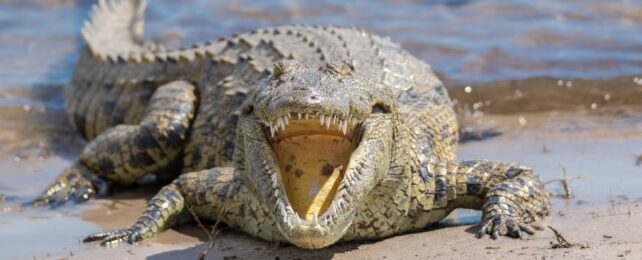A research team in France found the Nile crocodile reacts to the distress cries of many different baby mammals, including humans.
Their response is sensitive to specific acoustic details, which may help the predators gauge the severity of their prey's distress before attacking.
By playing recordings of crying bonobos (Pan paniscus), chimpanzees (Pan troglodytes), and humans, the researchers discovered Nile crocodiles are most drawn to the infants in the greatest states of distress.
According to earlier studies, crocodiles are known to become alert when potential prey makes a distress sound, and they frequently move toward the sound in an attempt to nab a low-effort snack. The scientists behind this latest investigation were curious about whether or not crocodiles reacted the same way to primates.
The vocalizations of primate infants aged 4 years or younger were transmitted to groups of Nile crocodiles (Crocodylus niloticus) via speakers placed near the ponds where more than 300 of these animals live in a Moroccan zoo. Behavioral ecologist Julie Thévenet from the University of Saint-Etienne in France and colleagues then studied the crocodiles' reactions.
C. niloticusis is the largest freshwater predator in Africa. The adult males usually weigh between 225 and 750 kilograms (500 and 1650 pounds), though records suggest they can reach a whopping 1,000 kilograms and terrifying lengths of 6.1 meters (20 feet).
The previously recorded sounds of primate infants were captured in a variety of situations to document a wide range of emotions. For example, human babies in low distress situations during bath time at home versus high distress while receiving vaccinations.
Their cries were classified based on 18 acoustic variables and clustered into three 'acoustic dimensions' based on pitch, harmonicity, and deterministic chaos.
Thévenet and team assessed the crocodiles' response based on the percentage of individuals in a group that responded to a recording. They didn't keep a tally of the sexes, but when the cries were played, both males and females turned their heads or moved toward the noise, with some going as far as biting the speakers.
However, the researchers discovered the large reptiles' reaction was conditional on the nature of the cries they had heard. Only about a fifth of the crocodiles responded to recordings of human babies in mild distress, while about a third of the crocs responded to recordings of babies in severe distress.
Results from a study of human subjects exposed to the same stimuli provide evidence that crocodiles and humans use distinct acoustic criteria in evaluating the distress levels in infant cries.
The pitch of a cry is a standard metric humans use to evaluate the emotions of their own infants. In fact, human subjects often misread high-pitched bonobo cries as severely distressed.
While pitch can often indicate distress, it varies between species and individuals and is less reliable than acoustic characteristics like disharmony, noise bursts, and jitter, which the study found were more likely to cause a response from crocodiles.
The acoustic features that trigger a crocodile's reaction are probably more accurate indicators of distress than human methods. And by not paying attention to pitch, their responses are less dependent on the species making the sound, a factor that doesn't really affect whether the sound means food, as they are generalist predators.
The team says perhaps crocodiles have perfected this ability so they can zero in on defenseless prey.
"Our experiments obviously do not mean that crocodiles cannot be attracted by other signals than distress calls – they are opportunistic hunters," the authors note, "but they suggest that the readiness of these animals to react increases with the presence of acoustic features marking a level of distress."
The study has been published in Proceedings of the Royal Society B: Biological Sciences.
